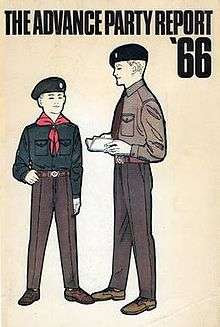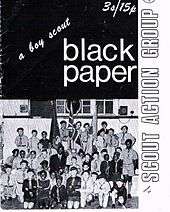The Chief Scouts' Advance Party Report
 Cover of the Popular edition | |
| Author | The Boy Scouts Association |
|---|---|
| Language | English |
| Genre | Non-fiction |
| Publisher | Kent Paper Company Ltd (first edition) |
Publication date | 1966 |
| Media type | |
The Chief Scouts' Advance Party Report was a publication produced in 1966 by The Boy Scout Association in the United Kingdom, intended to modernise the Scout Movement. The report was attempting to address falling numbers within the Movement.[1]
The Advance Party
The Chief Scout's Advance Party was formed in January 1964, when 24 Scout Leaders under the age of 45 were invited to "study all apects of the future of Scouting and to make recommendations, after consultation with the Movement, to the Chief Scout as to the development of the Movement, both in the immediate future and for the 1970s."
The Advance Party met as a body for six weekends, with various sub-committees holding an additional 166 meetings and the chairmen of these committees meeting on three occasions.
Members of the Chief Scout's Advance Party
Chairman: The Chief Scout, Sir Charles Maclean
Secretary: E.W. Hayden; Training Secretary, Headquarters
- J.W. Bereford; Senior Scout Leader and Assistant County Commissioner (Senior Scouts)
- P.R. Blanchflower; Scoutmaster and Assistant Deputy Camp Chief in Surrey
- Major R.H. Carr-Ellison; County Commissioner for Northumberland
- Hon. R.H.V. Cochrane; Scottish HQ Commissioner for Rover Scouts
- J.N. Coffey; Assistant County Commissioner in East Cheshire
- C.A. Cutress; Group Scoutmaster and District Commissioner in Sussex
- D.F. Dunford; District Commissioner in Monmouthshire
- J.M. Elliot; Assistant County Commissioner in Surrey
- D.W.R. Evans; Assistant County Commissioner in Essex
- C.R. Griffin; Cubmaster in Greater London Central
- Sqn. Ldr. D. Grisbrook; Senior Scout Leader in Leicestershire, HQ Commissioner Cyprus
- Sqn. Ldr. C.M. Henderson; Travelling Commissioner Scotland
- Dr. P. Johnson; District Commissioner and Deputy County Commissioner in Hampshire
- K.C. Lock; Formerly District Commissioner in North Staffordshire
- Lt. Col. H. Mainwaring; Group Scoutmaster and Assistant Commissioner in Cambridgeshire
- J.C. Moorman; assistant County Commissioner in Somerset
- W.B. Moule; Headquarters Commissioner for Wolf Cubs and Akela Leader in Sussex
- J.A.P. Norris; District Commissioner in Manchester
- D.I.N. Olliver; Assistant County Commissioner in Central Yorkshire
- G.S. Preshner; Group Scoutmaster and Assistant Deputy Camp Chief in London
- J.N. Price; District Commissioner in Lancashire, North West
- L.C. Reynolds; County Secretary and Assistant County Commissioner in Westmorland
- K.H. Stevens; Deputy Chief Executive Commissioner at Headquarters
- J.B. Young; Assistant County Commissioner in Glasgow
The Report
The final report to the Committee of the Council was 200,000 words long. This was reduced to 50,000 words in a published "Popular Edition" through summarising and omitting many of the arguments relating to the 409 recommendations.
Key recommendations
1 That the Boy Scouts Association be renamed as The Scout Association.
2 Wolf Cubs be renamed Cub Scouts.
3 That the Scout and Cub Scout Promise be the same, with the removal of the phrases "On my honour" and "at all times".
4 That the original Scout Law be re-written, becoming-
- A Scout does his best to honour his promise.
- A Scout is to be trusted.
- A Scout is loyal.
- A Scout is friendly and considerate.
- A Scout is a brother to all Scouts.
- A Scout has courage in all difficulties.
- A Scout makes good use of his time and is careful of possessions and property.
- A Scout has respect for himself and others.
5 That a new training and advancement scheme be introduced.
6 All Sections should use the same Scout salute.
7 That "Be Prepared" be the motto for the whole Scout Movement.
8 That the minimum age for entry into the Scout Movement be 8 years, with no pre-Cub training.
9 That the maximum age for membership of a Training Section of the Movement be 20 years.
10 That there be three Training Sections in the Movement;
- Cub Scouts (ages 8 to 11)
- Scouts (ages 11 to 16)
- Venture Scouts (ages 16 to 20)
11 That Scout Troops of approximately 36 members be formed by amalgamation or pooling of resources of smaller troops.
12 That the registration of Lone Scouts be discontinued.
13 That a set of minimum standards be introduced, with Groups failing to meet these standards being closed;
- Minimum number of young people (Cub Scouts: 12, Scout Troop: 12, Venture Scouts: 9)
- Minimum number of leaders (At least 2 adults for each section)
- Minimum level of progress made by members of each section
- Appropriate programme being operated by each section
14 That a maximum age-limit for Scouters and Commissioners be introduced.
15 That there be an increase in the number of paid Scouters.
16 That shorts will only be worn as part of the uniform by members of the Cub Scout section.
Implementation
Following the publication of the Report a further document called Design for Scouting was published, outlining which of the Advance Party's recommendations had been accepted by the Committee of the Council. Only a few of the proposals were amended. Notably, it was decided against the deletion of "On my honour" from the Scout Promise; this obviated the need for the first of the proposed eight Scout Laws, leaving only seven. The suggestion that the Wood Badge insignia (for adult leader training) be replaced by a cloth emblem was also not adopted.[2]
The first changes to be implemented were the adoption of the new Laws and Promises in October 1966 followed in May 1967 by the formal name change from The Boy Scouts' Association to The Scout Association. In October of that year, the new uniform was introduced along with the new training schemes, including the launch of the Venture Scout section.[3]
Outcomes

Such radical change was not welcomed by all members and a reply, A Boy Scout Black Paper, was produced in 1970 by "The Scout Action Group".[4] This provided some alternative proposals for the development of the Movement and asked for Groups that wished to continue to follow Baden-Powell's original scheme to be allowed to do so. The content of this paper was not accepted by The Scout Association, resulting in a split developing in the Movement and the formation of the Baden-Powell Scouts' Association.[5]
The front cover of the Black Paper featured a photograph of a Scout Group in South East London which, according to the foreword of the document, was forced to close under APR due to the leader being aged 65 despite no replacement leader being available. The Paper concludes with a copy of the letter from North and Central Lambeth Scout Council refusing to re-register and, therefore, forcing the closure of the Group.
Following several years of reduction in overall numbers, the annual census of 31 March 1969 (18 months after the implementation of the Report) showed modest increases across two sections of the Association. The total of 531,011 included 249,561 Cub Scouts, 188,379 Scouts and 21,698 Venture Scouts in 11,704 Scout Groups. The total number of young people in the Association who were within the reduced Statutory Youth Service age range of 14 to 21 was over 81,000.[6]
The Advance Party Report failed to recover the losses of older boys, with 55,206 Senior Scouts and Rover Scouts recorded in 1966 having been replaced by 21,698 Venture Scouts in the 1969 figures. The highest recorded membership of the Venture Scout section was 39,307 in 1989 (after the 1976 admission of girls into the Venture Scout section).
By March 1978, a decade after implementation, the overall Scout Association total had risen to 636,148, including 308,152 Cub Scouts, 207,276 Scouts and 27,905 Venture Scouts (of whom, 2,218 were girls). The number of Scout Groups had fallen to 11,464, reflecting the policy of amalgamating smaller units which had been proposed by the Advance Party.[7] By 1998 the majority (68%) of members of The Scout Association were under 11 years old.[8]
Further reviews
The training schemes of the Scout Association were reviewed several times in the succeeding decades. A new training scheme and progress awards for the Scout section were launched in April 1985,[9] Against the recommendations of APR, the Beaver Scout section for 6 and 7 year olds launched in April 1986 after a trial scheme and in February 1990, it was decided in principle that the Association would become fully co-educational.[10] A new training scheme for Cub Scouts was launched in September 1990.[11]
In May 2000 a new report called simply The Programme Review was received by the Committee of the Council after extensive consultation with members of the Association and focus groups. A uniform review was conducted shortly afterwards. The new uniforms were launched during London Fashion Week in 2001 and implementation of the new training programmes began in 2002. This included splitting Ventures back into two sections, Explorer Scouts (14−18) and Scout Network (18−25);[12] effectively restoring the pre-APR age boundaries by December 2003.[13]
See also
References
- ↑ "The growing crisis in the Scout movement". Scout History Society. Retrieved 2008-11-27.
- ↑ http://www.thedump.scoutscan.com/design.pdf The Chief Scout's Advance Party decisions (PDF)
- ↑ Moynihan, Paul; Baden-Powell, Lord (2006). Official History of Scouting: A Step-by-Step Guide. Hamlyn. pp. 180–1. ISBN 978-0-600-61398-5.
- ↑ Scout Action Group (1970). A Boy Scout Black Paper. Scout Action Group. p. 1970. ISBN 978-0-9501609-0-0.
- ↑ Baden-Powell Scouts' Association
- ↑ The Scouter, Volume LXIII No 10, October 1969 (pp. 276−7)
- ↑ Scouting Magazine, Volume LXXII No 9, September 1978 (p. 645)
- ↑ The Crisis in The Scout Movement
- ↑ An Official History of Scouting (p. 183)
- ↑ An Official History of Scouting, Hamlyn, 2006, ISBN 978-0600613985 (p.184)
- ↑ Leaders' and Commissioners' Guide to Supporting the Cub Scout Leader with the New Cub Scout Scout Programme. 1990. p. 8. ISBN 978-0-85165-240-5.
- ↑ "Scouting Magazine: February 2001 - The form of the new provision for Young People". www.scoutbase.org.uk retrieved from web.archive.org. The Scout Association. Archived from the original on January 8, 2009. Retrieved 23 November 2015.
- ↑ An Official History of Scouting (p.185)
Bibliography
- "The Advance Party Report '66". The Boy Scouts Association. 1966.
- "A Boy Scout Black Paper". Scout Action Group. 1970.
- The Advance Party Report viewable online
- The Chief Scout's Advance Party decisions (PDF)